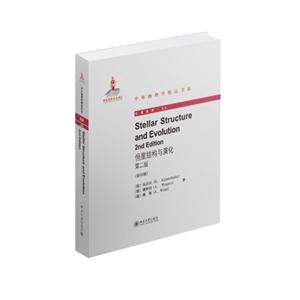恒星结构与演化-第二版-(影印版)


|
恒星结构与演化-第二版-(影印版)作者:基彭汉 开 本:16开 书号ISBN:9787301251751 定价:106.0 出版时间:2014-12-01 出版社:北京大学出版社 |
15.3 limiting cases
15.4 partial degeneracy of the electron gas
16 the equation of state of stellar matter
16.1 the ion gas
16.2 the equation of state
16.3 thermodynamic quantities
16.4 crystallization
16.5 neutronization
16.6 real gas effects
17 opacity
17.1 electron scattering
17.2 absorption due to free-free transitions
17.3 bound-free transitions
17.4 bound-bound transitions
17.5 the negative hydrogen ion
17.6 conduction
17.7 molecular opacities
17.8 opacity tables
18 nuclear energy production
18.1 basic considerations
18.2 nuclear cross sections
18.3 thermonuclear reaction rates
18.4 electron shielding
18.5 the major nuclear burning stages
18.5.1 hydrogen burning.
18.5.2 helium burning
18.5.3 carbon burning and beyond
18.6 neutron-capture nucleosynthesis
18.7 neutrinos
part iv simple stellar models
19 polytropic gaseous spheres
19.1 polytropic relations
19.2 polytropic stellar models
19.3 properties of the solutions
19.4 application to stars
19.5 radiation pressure and the polytrope n d 3.
19.6 polytropic stellar models with fixed k
19.7 chandrasekhar's limiting mass
19.8 isothermal spheres of an ideal gas
19.9 gravitational and total energy for polytropes
19.10 supermassive stars
19.11 a collapsing polytrope
20 homology relations
20.1 definitions and basic relations
20.2 applications to simple material functions
20.2.1 the case ? d 0
20.2.2 the case ? d ? d ' d 1; a d b d 0
20.2.3 the role of the equation of state
20.3 homologous contraction
21 simple models in the u-v plane
21.1 the u-v plane
21.2 radiative envelope solutions
21.3 fitting of a convective core
21.4 fitting of an isothermal core
22 the zero-agemain sequence
22.1 surface values
22.2 interior solutions
22.3 convective regions
22.4 extreme values of m
22.5 the eddington luminosity
23 other main sequences
23.1 the helium main sequence.
23.2 the carbon main sequence.
23.3 generalized main sequences
24 the hayashi line
24.1 luminosity of fully convectivemodels
24.2 a simple description of the hayashi line
24.3 the neighbourhood of the hayashi line and the forbidden region
24.4 numerical results
24.5 limitations for fully convectivemodels
25 stability considerations
25.1 general remarks
25.2 stability of the piston model
25.2.1 dynamical stability
25.2.2 inclusion of non-adiabatic effects
25.3 stellar stability
25.3.1 perturbation equations
25.3.2 dynamical stability
25.3.3 non-adiabatic effects
25.3.4 the gravothermal specific heat
25.3.5 secular stability behaviour of nuclear burning
part v early stellar evolution
26 the onset of star formation
26.1 the jeans criterion
26.1.1 an infinite homogeneous medium.
26.1.2 a plane-parallel layer in hydrostatic equilibrium
26.2 instability in the spherical case
26.3 fragmentation
27 the formation of protostars.
27.1 free-fall collapse of a homogeneous sphere
27.2 collapse onto a condensed object
27.3 a collapse calculation
27.4 the optically thin phase and the formation of a hydrostatic core
27.5 core collapse
27.6 evolution in the hertzsprung-russell diagram
28 pre-main-sequence contraction.
28.1 homologous contraction of a gaseous sphere
28.2 approach to the zero-age main sequence
29 from the initial to the present sun
29.1 known solar data
29.2 choosing the initial model
29.3 a standard solar model
29.4 results of helioseismology.
29.5 solar neutrinos.
30 evolution on the main sequence
30.1 change in the hydrogen content
30.2 evolution in the hertzsprung-russell diagram
30.3 timescales for central hydrogen burning
30.4 complications connected with convection
30.4.1 convective overshooting
30.4.2 semiconvection
30.5 the sch¨onberg-chandrasekhar limit
30.5.1 a simple approach: the virial theorem and homology
30.5.2 integrations for core and envelope.
30.5.3 complete solutions for stars with isothermal cores
part vi post-main-sequence evolution
31 evolution through helium burning: intermediate-mass stars
31.1 crossing the hertzsprung gap
31.2 central helium burning
31.3 the cepheid phase.
31.4 to loop or not to loop
31.5 after central helium burning
32 evolution through helium burning: massive stars
32.1 semiconvection
32.2 overshooting
32.3 mass loss
33 evolution through helium burning: low-mass stars
33.1 post-main-sequence evolution
33.2 shell-source homology
33.3 evolution along the red giant branch.
自然科学 天文学
在线阅读
- 最新内容
- 相关内容
- 网友推荐
- 图文推荐
| [高考] 2022 西安电子科技大学《软件工程》大作业答案 (2022-04-25) |
| [家长教育] 孩子为什么会和父母感情疏离? (2019-07-14) |
| [教师分享] 给远方姐姐的一封信 (2018-11-07) |
| [教师分享] 伸缩门 (2018-11-07) |
| [教师分享] 回家乡 (2018-11-07) |
| [教师分享] 是风味也是人间 (2018-11-07) |
| [教师分享] 一句格言的启示 (2018-11-07) |
| [教师分享] 无规矩不成方圆 (2018-11-07) |
| [教师分享] 第十届全国教育名家论坛有感(二) (2018-11-07) |
| [教师分享] 贪玩的小狗 (2018-11-07) |







